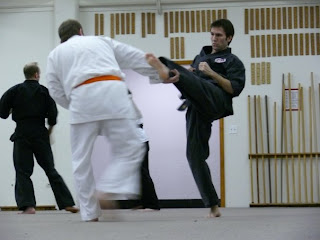Post By: Lee Phelan
However, I believe things can be made much simpler, especially in light of Sensei Harp's letter. Students in the martial arts need to work hard and be tough. I don't necessarily mean cranking out a hundred handstand push-ups or walking on broken glass. There are many other things students and teachers can do to meet these two concepts.
As soon as you enter the floor, get to work. Do not talk about that jerk at work, how much homework you have, or your annoying relatives. I realize this can be difficult, especially when friendships develop within the dojo. But remember, the only talk should be about martial arts. So unless you have a specific question about a technique or kata, start working.
Come to class with the intention of doing your best. If you have an injury or condition you think will hamper you, either stay home or readjust what you are doing the best you can. Complaining to a Sensei or other students will only give you an excuse to take it easy, which negates both concepts.
Think about your uniform. If you only have a lightweight gi, consider switching to a heavy weight. The heavy weight gis will help with your training. It makes performing strong techniques irresistible, since hearing that nice SNAP becomes addicting. It also helps get you in the right mindset, just like wearing formal dress for an important event.
Keep the smiling and giggling down to a minimum. Some humor and being friendly is fine, but be careful not to take it too far. If you are laughing or talking with your partner more than you are working, you may have a problem.
Face your fears. If sparring is scary for you, do it anyway, but without showing your fear. Acting afraid of your opponent will only give them power. I think it is important to continually challenge your fears. For me facing my fears through sparring is a huge affirmation to my martial arts training. Yes, you read that right. There are people I spar with who scare me.
Everyone struggles with these concepts, and no one is perfect. It takes effort and a strong sense of character to start practicing while others are talking, or to put on the heavy weight gi when it is eighty degrees outside. However, your training both physically and mentally will greatly improve, and your goals will become even closer to your grasp.
Photo by: Teerapun



